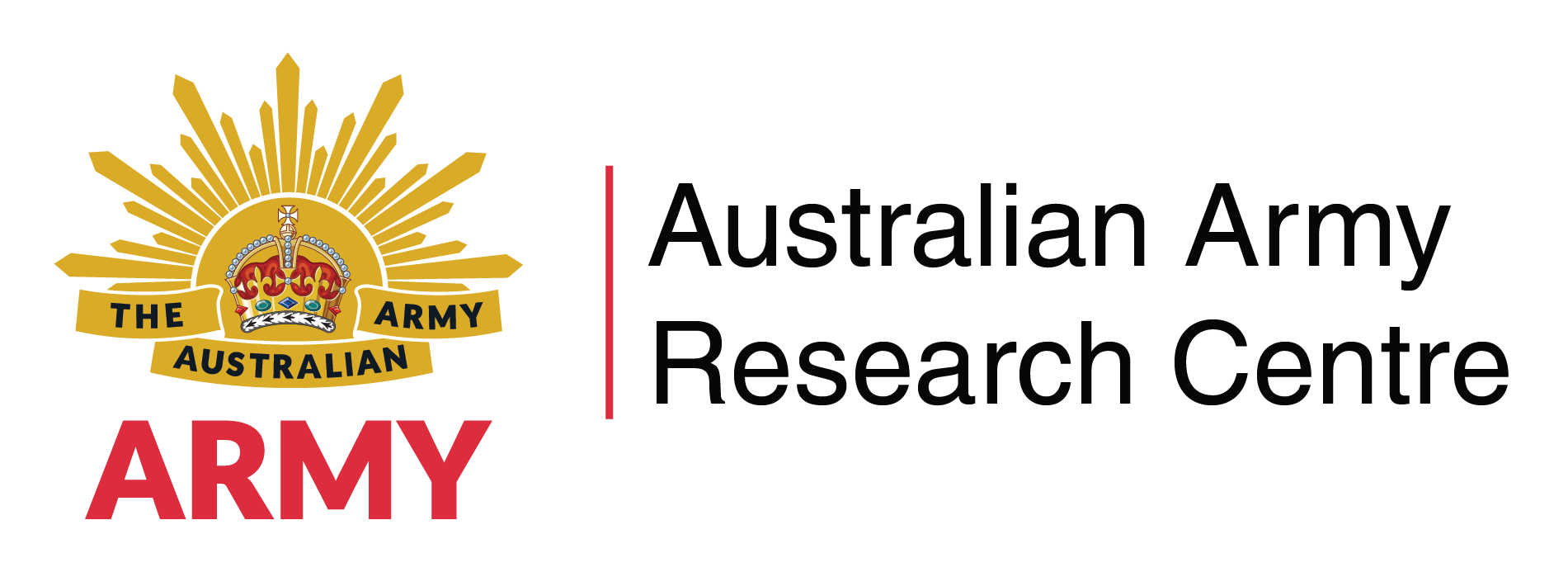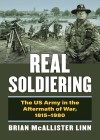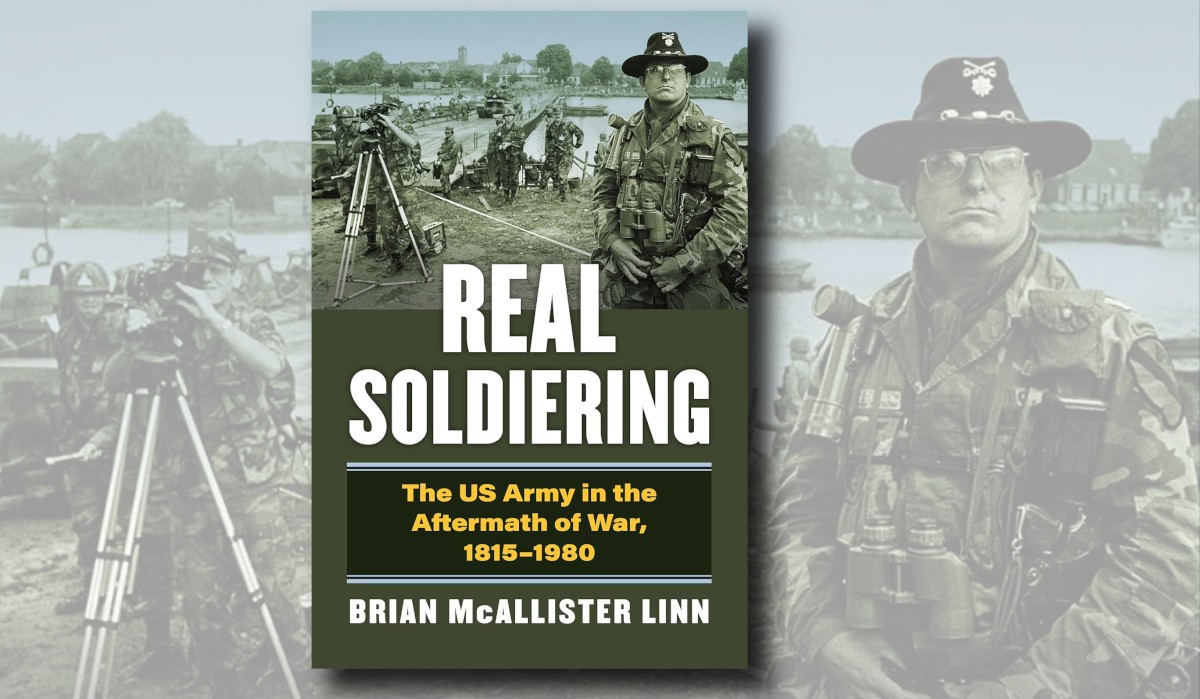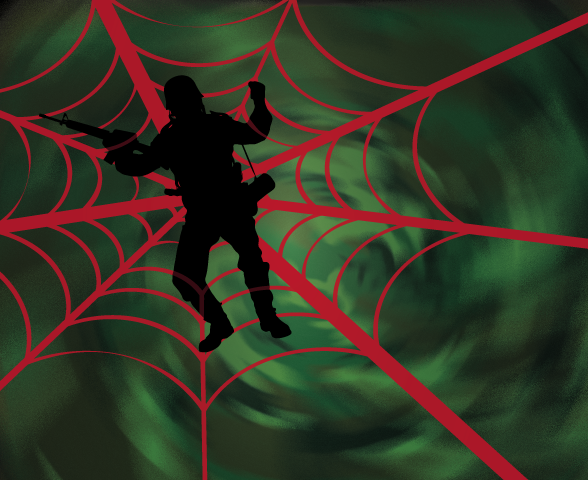the US Army in the Aftermath of War, 1815-1980
University Press of Kansas, 2023, 300 pp RRP: US$54.99
Hardcover ISBN: 9780700634750
Author: Brian McAllister Lynn
Reviewed by: Dayton McCarthy
…in the historical experience of the US Army, real soldiering took place during periods of financial and manpower cuts, with little glory, an uncertain future and few immediate rewards…the army’s fundamental post war challenge was not securing higher budgets, writing a new doctrine, purchasing better equipment or reshuffling the Pentagon’s bureaucracy. Rather, what would determine whether the army successfully negotiated the aftermath of war would depend on those with ‘the will to soldier for peace in a peacetime army.’[1]
This is not an easy book to read. It does not cover battlefield defeats or successes, acts of heroism or cowardice, or inspired command or wartime ineptness. Rather it seeks to recount how an organisation – the US Army – confronted the realities of peace after a period of conflict.
Many military readers will find that Brian McAllister Lynn’s Real Soldiering: the US Army in the Aftermath of War, 1815-1980, a confronting and perhaps frustrating tome that resonates just a little too much with their own experiences. This gloomy caveat should not dissuade readers of the Land Power Forum: Real Soldiering is an important and well-written book for any military professional who seeks to understand the ebb and flow of an army in periods of peace.
Lynn’s book is ambitious: it seeks to recount how the US Army fared and responded to the periods of consolidation, introspection, reviews, initiatives, personnel and financial cut-backs and challenges within eight post-war epochs. This is no mean feat as one can appreciate that the contexts and circumstances of each of these epochs (the War of 1812, the American Civil War, the Cuban and Philippines expeditions, the First and Second World Wars, the Korean and Vietnam Wars and the Cold War) were very different. Yet Lynn manages to weave themes together and demonstrate that the challenges faced – and the US Army’s response to them – were remarkably similar. In doing so, a consistent narrative thread links together these seemingly very different post-war epochs.
Lynn is a history professor at Texas A&M University and a former lecturer at the US Army War College. He has past form in tackling the less glamourous episodes of American military history and in doing so, producing insightful studies of the US Army as an organisation.[2] In Real Soldiering, Lynn is keen to delineate between military history and the history of the military. To situate his study, Lynn quotes Colonel Oliver L. Spaulding, who in 1937, had written his own study of the US Army:
While the Army is organised to fight, fighting occupies only a small part of the time of any particular unit. Often we find some peaceful incident having greater influence upon the Army than some active campaign.[3]
The first chapter is perhaps the most ambitious, and for this reviewer perhaps the least structured. It seeks to cover the period from 1812 (but really starting with observations on the post-War period of the Independence Continental Army) through to the thirty-year period after the American Civil War: in other words, nearly a century of change in one chapter. For the Australian reader, this first chapter may also be the most challenging to understand unless they have a working knowledge of political, military and organisational contexts of the War of 1812 and the American Civil War. To an extent, this criticism extends, albeit to considerably lesser degrees, to all chapters in this book. Necessarily, Lynn starts each chapter in the period after the respective conflict, and while some salient context is provided, for the reader to gain the insights Lynn is providing, they must have basic knowledge of the preceding events.
Even so, the first chapter lays the foundations for the rest of the book. In the nineteenth century, the regular army came into existence, the United States Military Academy (USMA) was established, the bureaucratisation of the War Department increased (which many in the Army at the time considered made things worse not better) and military doctrine heavily influenced by Napoleonic practices was adopted. Importantly, we see the first of two recurring themes appearing. What was the raison d’etre of the regular army versus the part-time one? Despite grandiloquent aspirations to pursue Napoleonic methods, the small regular army was dispersed across the nation to man coastal gun emplacements and frontier forts as well as conducting public works projects. The second recurring theme – that the underfunded post-war US Army was often the employer of last resort, especially among rank and file – first arises here. This resulted in an unbalanced force with a disproportionately large officer corps. And so the concept of the ‘expansible army’ arose, wherein peacetime hollowness was accepted on the expectation that the cadre of regular officers could train recruits if and when required, in sufficient time.[4] The Australian reader will relate to this ‘regulars versus militia’ debate that has plagued our history and see echoes of ‘skeleton’ or ‘nucleus’ force structures variously adopted by the Australian Army during peacetime periods.[5]
In a similar vein, the second chapter titled ‘Postscript to the Imperial Wars’, details the period after the Cuban and Philippines expeditions at the turn of the 20th century. Again, Australian readers may struggle for some context here, but they will certainly understand the tension within a force that believes it should prepare for a certain role, but find itself doing something else completely. In the US Army context, this issue was manifested in the contrast between training for a conventional war against a major power and undertaking constabulary actions in far-flung colonies. Ironically, the possession of overseas territories during a period of great power competition increased the possibility of a major war. These tensions played against the backdrop of the reforms instigated by the Secretary of War, Elihu Root.[6] While such reforms have been generally accepted as positive and modernising, Lynn cautions against viewing this period through the lens of the US Army in the First World War. In other words, the US Army prior to 1918 was not aware it would fight in France or that Root’s reforms prepared it do so. Lynn wrote that:
Most regulars were too busy dealing with the aftermath of the last war – personnel turbulence, demoralisation, absenteeism, intermittent tactical training, deployments and other such problems – to envision an army of four million fighting ‘the war to end all wars.’[7]
The chapters on the post First and Second War US Army are those that will really start to pique the interest of the LPF reader, as the similarities between the US and Australian experience are many. Lynn starts the post First World war chapter with the US Army in turmoil after a rapid and very haphazard demobilisation. While the demobilisation of the Australian Imperial Force (AIF) was measured and orderly, similar after-effects would arise. In the US Army’s case, National Guardsmen who had been mobilised for the war had been treated contemptuously by the Regular Army, with a poisonous relationship arising between two entities. The National Guardsmen saw themselves as the heirs of the American Expeditionary Forces (AEF) that had fought overseas; in a similar vein the interwar Citizen Forces/Militia carried on the traditions of the AIF. In 1920, Washington developed a defence policy and organisation that was essentially a framework for future mobilisation rather than a force in being. It made the regular army’s priority to train the massive citizen soldier reserve, and in time of war, conscripts. This was fine in theory, but within two years, funding would be cut, leaving – in the words of one contemporary observer – ‘a fine skeleton of an army.’[8] A decade later, with the onset of the Great Depression, coupled with budget cuts, conditions of service in the Army were dire. For regular officers, promotion opportunities dried up so it was not uncommon for lieutenants to spend twenty years reaching the rank of major, and as a result, in 1935 the average age of a lieutenant was thirty-four.[9] While the US had a regular standing army and Australia did not, the experience of our small inter-war Permanent Military Forces – a trainer and administrator of the Militia – was comparable.
If the AEF’s demobilisation was considered haphazard in 1918, the breakup of the triumphant Second World War US Army was considered more ‘a disintegration than a demobilisation.’[10] Within five years, the Army shrunk from 8,270,000 soldiers to 590,000 and coupled with the quest for the peace dividend, this situation meant that the US Army was woefully ill-prepared for the Korean War in 1950. Then, facing the nuclear-armed Soviet Union, the US Army struggled to determine its role – and thus funding – in an era of missiles and strategic bombers. Enter the ‘Pentomic’ organisation launched with much fanfare:
This was not yesterday’s slug-it-out instrument of attrition but rather a small, light mobile force able to manoeuvre over vast distances, equipped with space-age technology, and packing devastating firepower.[11]
Australia would copy the US and adopt the ‘Pentropic’ organisation in the late 1950s, spruiking many of the same selling points, and like the US, quietly discard it within two years due to multiple issues and shortcomings with the organisation.
The 1950s saw the re-establishment and rapid successful expansion of the Reserve Officers Training Corps (ROTC) wherein regular and reserve commissions could be gained by those studying at American universities. Such was its success that, by the mid-1950s, ROTC graduates outnumbered USMA graduates entering the regular army. This posed an interesting challenge for the US Army: its younger officers were educated but its middle and senior officers - many commissioned during the war – were not. This necessitated a massive professional education programme for these officers. Likewise, with an ongoing selective service draft, the Army was in a state of constant turmoil as it assimilated, trained and discharged these short service draftees, while attempting to recruit high-quality (and longer serving) volunteers in a period of good economic conditions.[12]
The centrepiece of the book could be the last chapter: how the US Army rebuilt itself after the nadir of the Vietnam War into the force that decisively won the first Gulf War in 1991. Most Australians would be aware of the issues here. The US Army, despite many battlefield successes had not emerged victorious but instead was plagued by racism and drug use and, worst of all, its reputation was in tatters after the My Lai massacre. This required serious introspection. One analysis determined the bulk of the fighting and dying in Vietnam was not by regulars but by draftees and short service commissioned officers from the ROTC or the crash course Officer Candidate School.[13] And so over the next two decades, the US Army embarked on a sustained program of education, training and professionalisation. There were some notable successes such as the full integration of the Women’s Army Corps into the US Army, including the admission of women in the USMA in 1976. The US Army worked assiduously on racism with a slow but steady improvement in the numbers of African-American soldiers joining, and more importantly the number of African-Americans as non-commissioned officers (NCOs) and officers.
Lynn gives due credit to the establishment of the US Army Training and Doctrine Command (TRADOC) and the seminal role of its first commander General William E. DePuy. TRADOC ‘became the centre of a concerted effort to build a new model army’ and, Lynn notes, ‘one that rejected the Vietnam experience and looked toward (or more accurately, back to) the repulse of a Soviet arrack on NATO.’[14] In addition, DePuy insisted that the US Army must attain ‘technological supremacy’ and ensure that it ‘remains a foundation of not only doctrine but also of army self-identity.[15] But problems remained to mar these successes. Conditions of service remained poor which meant that attracting high quality soldiers for the now all-volunteer army was a constant challenge. Likewise, many NCOs who were rapidly promoted for service in Vietnam progressed in seniority but were found wanting. This situation required further investment in NCO training and education.
Lynn concludes the book with a postscript, ‘The Aftermath Army in Perspective.’ He notes that most historians mark the 1991 Gulf War as the ‘transition from the wreckage of the Vietnam War-era army to the “Army of Excellence.”’[16] But Lynn cautions that this ‘Army of Excellence’ endured similar issues that the US Army experienced in other post-conflict periods. He concludes that it is a common institutional fallacy to confuse a pre-war force with a post-war force ‘and assessing it largely on its performance in a future war.’ To do so, Lynn warns, increases ‘the potential for misunderstanding and misinterpreting the distinct identities of aftermath armies.’[17]
About the Author
Endnotes
[1] General Michael E Davison quoted in Lynn, Brian McAllister, Real Soldiering: The US Army in the Aftermath of War, 1815-1980, University Press of Kansas, Lawrence, 2023, pp ix-x.
[2] For example, he studied the early 20th century US peace-time army in the Pacific and the post Second World War/Cold War US Army. See Lynn, Brian McAllister, Guardians of Empire: The U.S. Army and the Pacific, 1902-1940, University of North Carolina Press, Chapel Hill, 1997 and Elvis’s Army: GIs and the Atomic Battlefield, Harvard University Press, Cambridge, 2016.
[3] Colonel Oliver l Spaulding quoted in Lynn, Real Soldiering, opcit, p xi.
[4] Lynn, ibid, pp 11-17.
[5] For further details of the Australian context see Horner, D.M., 'Staff Corps versus Militia: The Australian experience in World War II,' Defence Force Journal, No. 26, Jan/Feb 1981, pp 13-26 or McCarthy, Dayton, The Once and Future Army. A History of the Citizen Military Forces, 1947-1974, Oxford University Press, South Melbourne, 2003.
[6] Ibid, pp 50-71.
[7] Ibid, p 73.
[8] Ibid, p 82.
[9] Ibid, 102.
[10] General George C. Marshall quoted in ibid, p 115.
[11] Ibid, p 132.
[12] Ibid, pp 136-149.
[13] Ibid, p 154.
[14] Ibid, p 159.
[15] Ibid, p 162.
[16] Ibid, p 196.
[17] Ibid, p 203.



